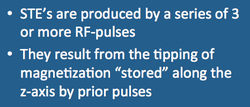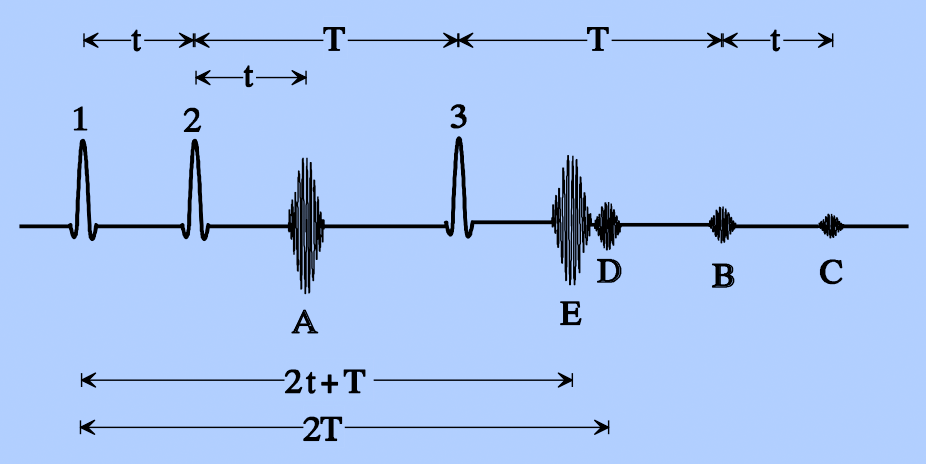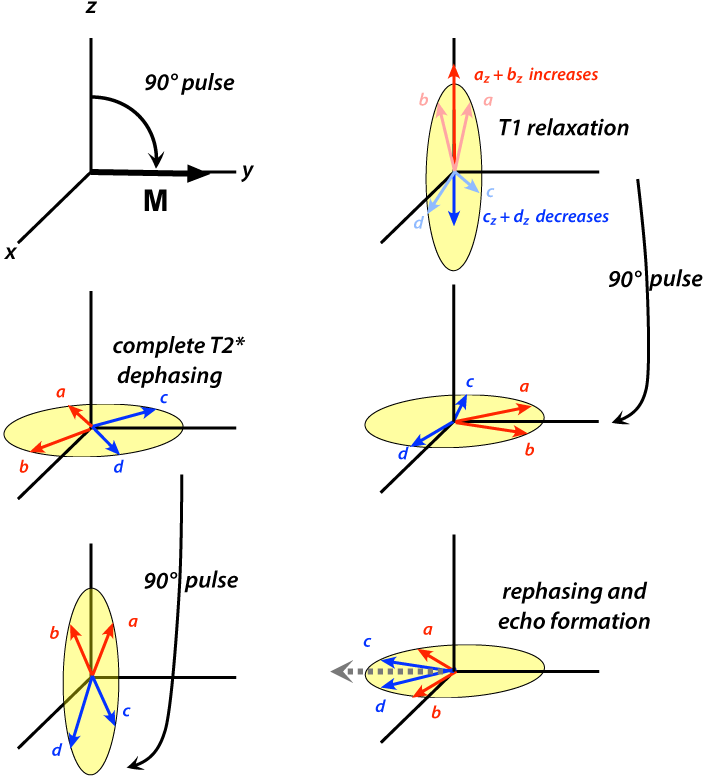|
Whereas a spin echo (SE) arises from the action of two RF pulses, a stimulated echo (STE) occurs from the action of three or more RF pulses. In the diagram (right) three RF pulses have miraculously produced five echoes! But from where did all these echoes arise?
|
Echo D is called a secondary spin echo and results from the spins in echo A being acted upon by RF-pulse #3 by the following mechanism: i) At the center peak of echo A spins in the transverse plane have once again been brought into phase. ii) Between the center of echo A and RF-pulse #3, these spins again dephase by T2* effects. iii) RF-pulse #3 flips over some of these spins allowing them to rephase and eventually refocus into Echo D. iv) Note that RF-pulse #3 is located exactly midway between Echoes A and D.
Echo E is the stimulated echo (STE). A spin-phase diagram similar to that in the last Q&A for the Hahn echo is used. We once again consider four spins (a,b,c,d) that have dephased after the initial 90°-pulse. Spins a and c are in local fields lower than Bo, are precessing slightly slower than the Larmor frequency, and are losing phase. Spins b and d are in local fields higher than Bo, precessing faster, and gaining phase. Moreover, we have picked the spin pairs (a-b) and (c-d) to have local field offsets of the same magnitude but opposite polarities, so they gain or lose phase relative to their partner at the same relative rates.
Advanced Discussion (show/hide)»
Assuming there is complete dephasing of spins during the interval between pulses 1 and 2 and diffusion effects are minimal, the maximum signal intensity of the STE produced by 3 pulses with flip angles α1, α2, and α3 with time interval spacings given by t and T in the diagram above is
M = ½ Mo • sin(α1) • sin(α2) • sin(α3) • e−[T/T1 + 2t/T2]
The magnitude of the stimulated echo is reduced by T2 effects in the first and third intervals, and by T1 effects in the middle interval.
As the number of RF-pulses increases, the number of echoes rises exponentially. For 4 RF-pulses, the number of echoes after the last pulse is 13; for 6 RF-pulses the number is 121! The equation governing the number of echoes after the nth pulse is given by the equation En= [3(n−1)−1]/2
Burstein D. Stimulated echoes: description, applications, practical hints. Concepts Mag Reson 1996;8:269-278.
Frahm J, Merboldt KD, Hänicke W, Haase A. Stimulated echo imaging. J Magn Reson 1985;64:81-93.
Frahm J, Bruhn H, Gyngell ML, et al. Localized high resolution proton NMR spectroscopy using stimulated echoes: initial applications to human brain in-vivo. Magn Reson Med 1988; 9:79-93.
Sattin W, Marcel TH, Scott KN. Exploiting the stimulated echo in nuclear magnetic resonance imaging. I. Method. J Magn Reson 1985;64:177-182.
Are stimulated echoes used for imaging? I've never heard of that.


